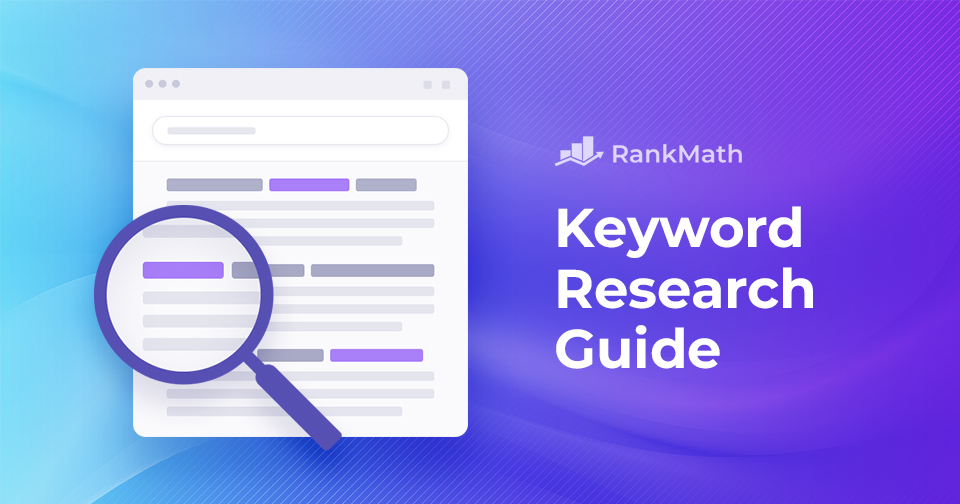You’ve probably heard the phrase, content is king. And while that’s true, I’ve learned that content alone isn’t enough to succeed online.
Without the right strategy behind it, even the most helpful or well-written content can easily get lost in the crowd.
That’s where keyword research comes in.
In this post, we’ll walk you through how I approach keyword research, from the basics to the tools and strategies that can help you attract the right audience and grow your traffic.

Table Of Contents
1 What is Keyword Research?
Keyword research is the process of finding out what words and phrases the audience uses when they search on Google or other search engines. It’s not just about knowing what’s popular, it’s about understanding what your audience is really looking for and why.
When you know the exact terms people are typing in and the intent behind those searches, you can create content that truly matches their needs. That gives your pages a better chance of showing up in search results and getting noticed.
For example, if someone searches for the best DSLR cameras, they’re probably ready to buy. But if they’re searching for how DSLR cameras work, they’re likely just looking for information. Knowing the difference helps you decide what kind of content to create and how to target it.
2 Importance of Keyword Research
Keyword research isn’t just a step in the SEO process—it’s what helps you attract the right people to your website. It’s not about getting as much traffic as possible; it’s about bringing in visitors who are actually interested in what you offer.
Here’s why I always prioritize keyword research—and why you should too:
You Improve Your Visibility: When you use the right keywords, your content is more likely to show up when people search for something related to your niche. Whether it’s a blog post, a product page, or a video, optimizing for keywords helps search engines understand what your content is about—and who it’s meant for.
You Gain a Competitive Edge: By researching keywords, you can also get insights into what your competitors are targeting. This helps you spot opportunities they may have missed and uncover content gaps you can fill. It’s like having a behind-the-scenes look at what’s working in your industry.
You Make Ads Work Smarter, Not Harder: If you’re running paid campaigns, keyword research is a must. It helps you choose more specific, relevant keywords that can improve your ad performance without draining your budget. For example, if you run an online pet store, targeting “buy cat food online” will likely convert better—and cost less—than broad terms like “pet supplies.”
You Create More Relevant, Valuable Content: When you understand what your audience is searching for, it becomes easier to create content that speaks directly to their needs. Keyword research helps ensure your content is not only useful but also discoverable, boosting trust, engagement, and rankings.
3 Understanding Keywords
Before you begin with keyword research, it’s important to understand the basics, especially the types of keywords and the intent behind them. Knowing this helps you choose terms that match your audience’s needs and improve your chances of ranking well.
Short-tail vs. Long-tail keywords
When you’re just starting out, it’s easy to focus on popular, broad terms—also known as short-tail keywords. These are usually one to three words long, like shoes or digital marketing. They get a lot of searches, but are highly competitive and not very specific.
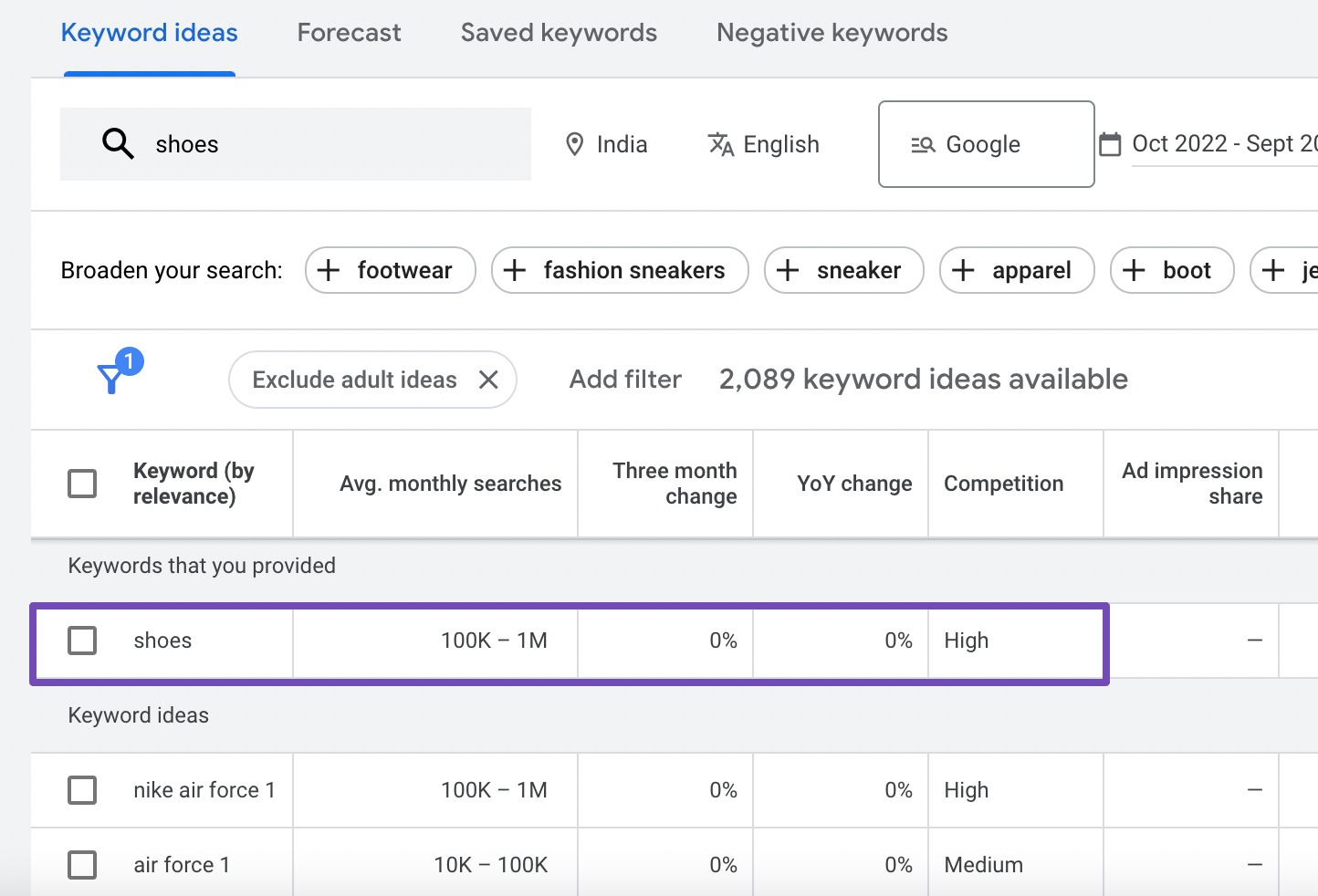
If someone is searching for a short-tail keyword, they’re often at the beginning of their research. They might not be ready to take action, which means those visitors may not convert right away.
That’s where long-tail keywords come in. These are longer phrases—usually three or more words—that are more specific and easier to rank for. They also bring in more qualified traffic.
Let’s say you run a blog about running. Instead of targeting a broad term like running shoes, you can focus on a long-tail keyword like best running shoes for athletes. It’s more targeted, less competitive, and likely to attract people who know what they want.
That’s why I recommend using a mix of short-tail and long-tail keywords in your strategy—it helps you reach both wide and highly focused audiences.
Keyword Intent (Informational, Navigational, Transactional)
Beyond just the words themselves, you need to understand why someone is searching. That’s called keyword intent, and it helps you create content that matches what the searcher really wants.

Informational Intent: This type of intent is driven by the audience seeking information or answers. When a user uses keywords like “how to,” “what is,” or “benefits of,” they’re likely looking for detailed explanations or solutions.
For instance, someone searching for “how to bake a chocolate cake” is clearly looking for a step-by-step guide or information.
Navigational Intent: Navigational intent comes into play when your audience is looking for a specific website or webpage. They already know where they want to go; they’re just using the search engine as a map to get there.
Keywords like “Facebook login,” “YouTube homepage,” or “Apple support” are examples of this intent. Users are looking to land on a particular site or page.
Transactional Intent: Audiences with transactional intent are ready to take action, whether making a purchase, signing up, or subscribing. Keywords like “buy,” “order,” “sign up,” or “download” signify transactional intent.
For example, someone searching for “buy iPhone 13 online” is in the mindset of making a purchase, and content that guides them to a product page or an online store is most relevant.
If you’re using Rank Math PRO, you don’t have to guess the intent behind your keywords. Just click on the Show Intent label to quickly understand whether a keyword is informational, navigational, or transactional. You can even move a different keyword to the first position to analyze its intent, making your content strategy even more accurate and relevant.

4 How to Find Keyword Ideas
Before you start optimizing content, you need a solid list of keyword ideas. But where do those ideas come from? Here are a few practical methods I use (and you can too) to build a keyword list that’s both relevant and effective.
4.1 Start With Your Own Ideas
The best place to begin is right where you are—your own knowledge, niche, and experience. Think about your business, your audience, and the products or services you offer.
Ask yourself:
- What questions do my customers frequently ask?
- What problems do I solve for them?
- What topics do I know well that others search for?
If you’ve created a buyer persona, you already have insights into what your ideal audience might be searching for. For instance, if you run a fitness blog for busy professionals, you can start with ideas like:
- Quick home workouts
- Best exercises for office workers
- How to stay fit with a desk job
These ideas don’t come from tools, they come from understanding your niche and audience.
4.2 Use Google’s Suggestions
Google is a goldmine for keyword ideas—you just need to know where to look.
Google Autocomplete
Start typing a word or phrase into the Google search bar and see what suggestions come up. These are real search terms people are using.
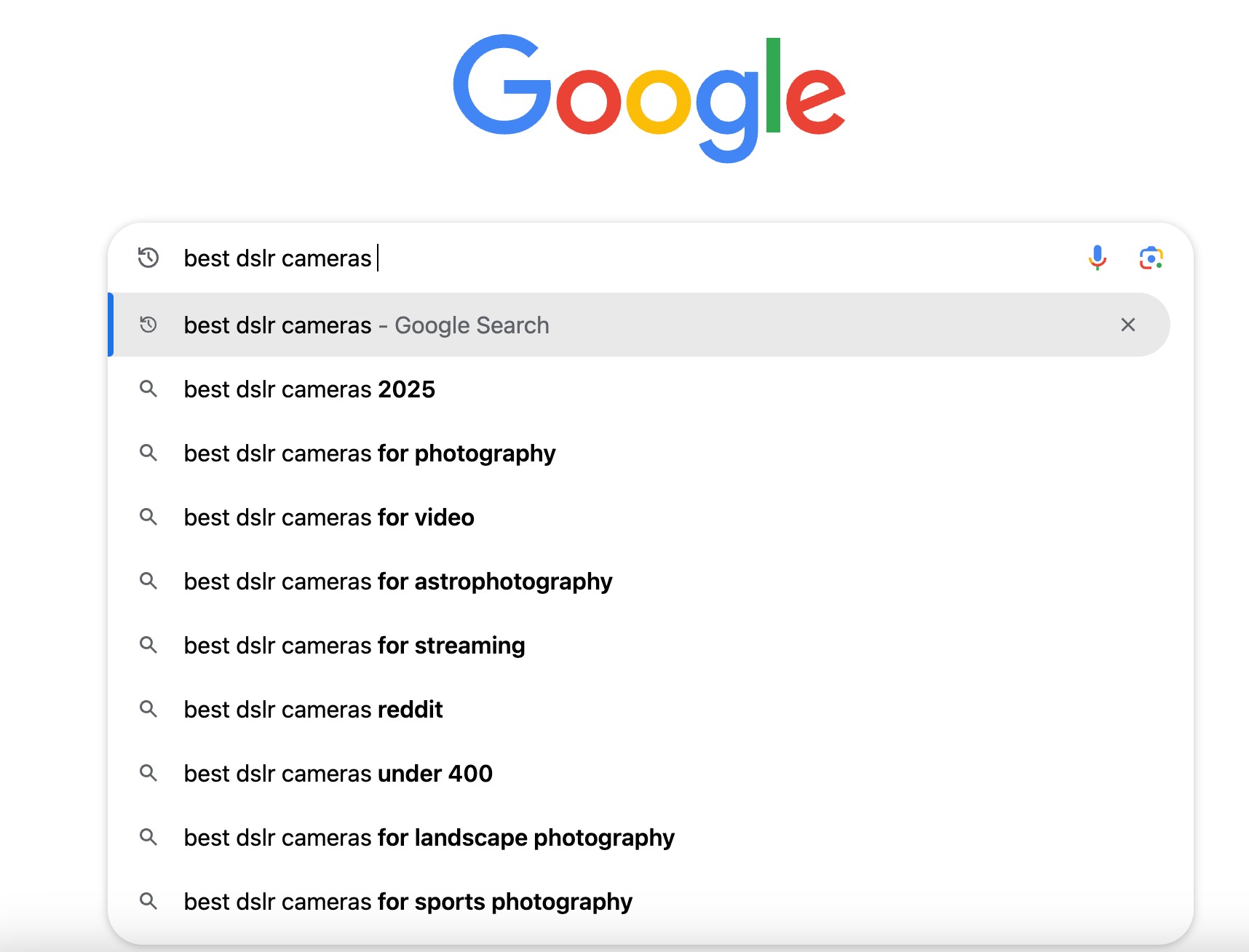
For example, type in “best DSLR cameras” and Google might suggest:
- Best DSLR cameras for photography
- Best DSLR cameras for video
- Best DSLR cameras under $400
Each of these is a potential long-tail keyword you can target.
Related Searches
Scroll to the bottom of the Google search results page, and you’ll find Related Searches. These often give you variations or niche-specific angles you might not have considered.
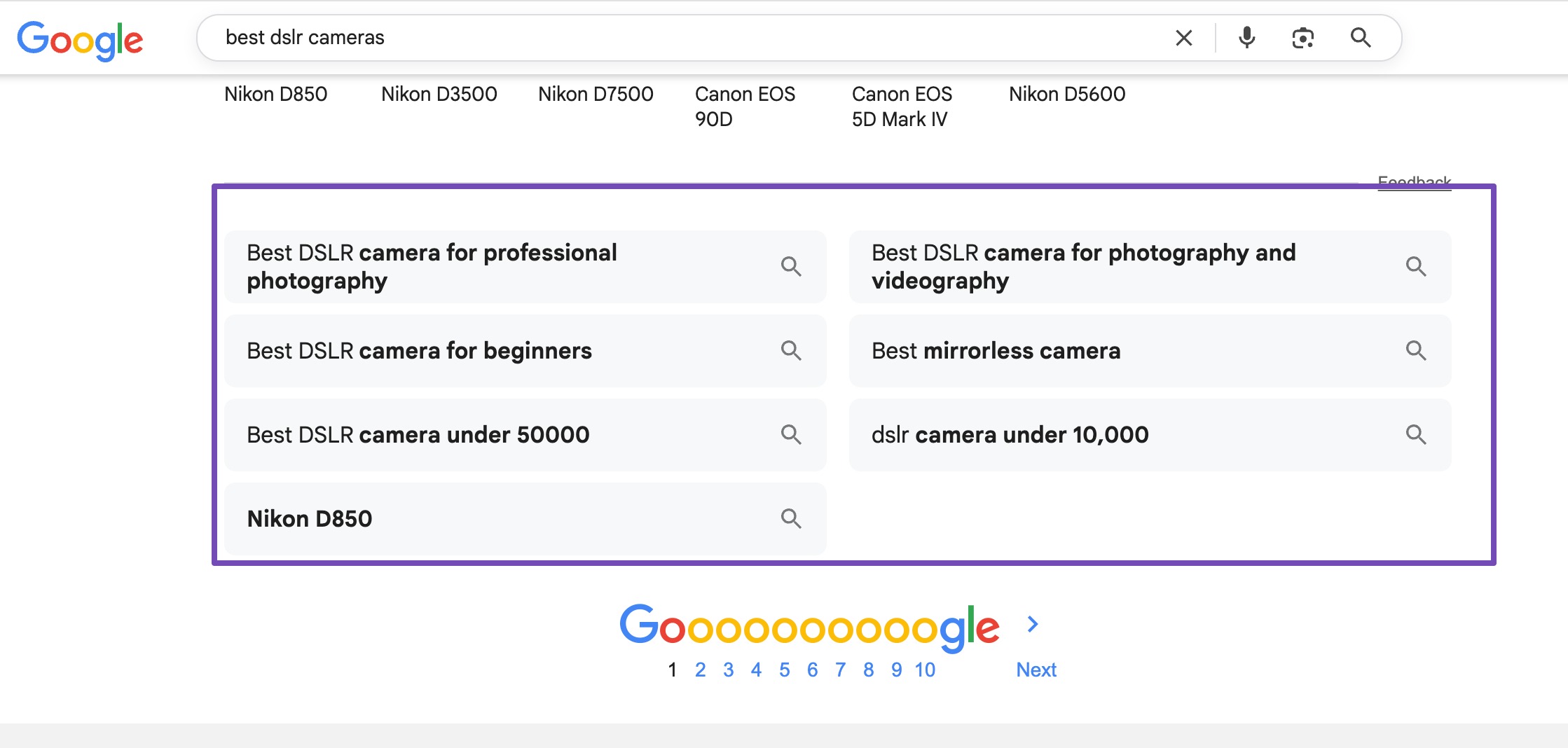
People also ask (PAA)
This is my favourite section for finding questions your audience is actively asking.
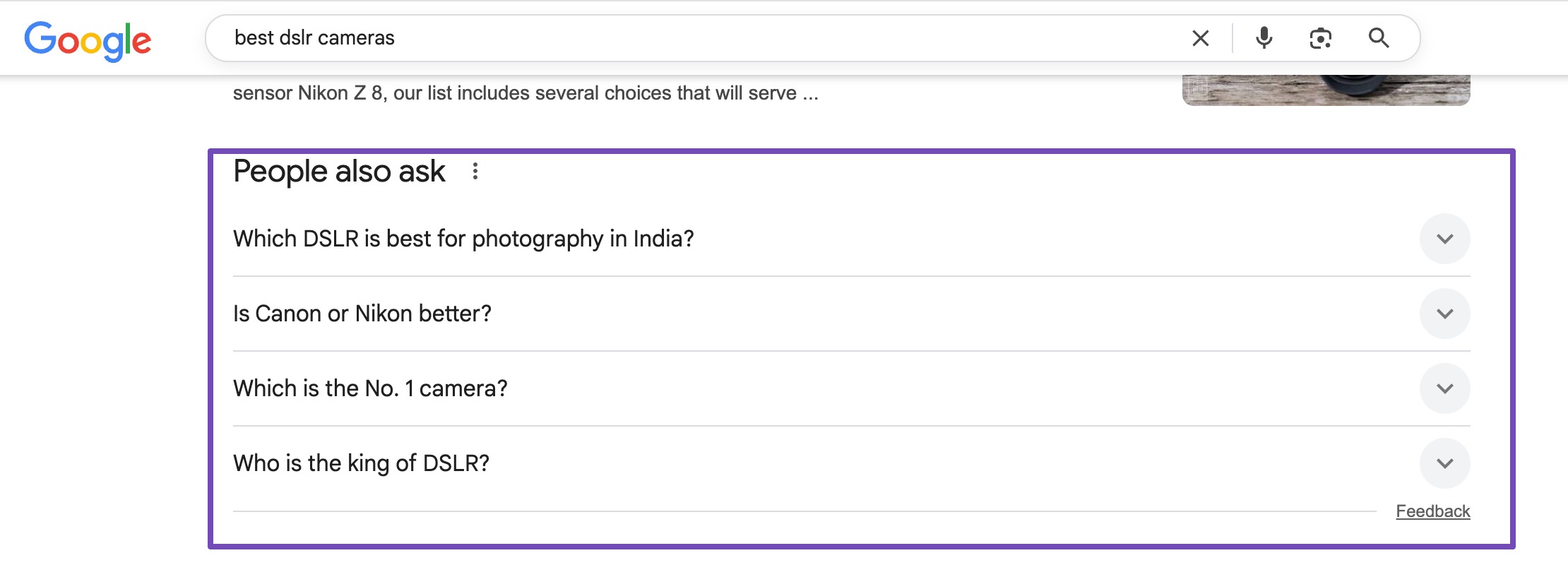
These questions make great blog post topics, FAQ sections, or content headers.
4.3 Use SEO Tools to Expand Your List
While brainstorming and Google suggestions are powerful, SEO tools take it a step further by giving you data, like search volume, cost per click, and intent.
Rank Math Content AI
Inside WordPress, Rank Math’s Content AI gives you keyword suggestions based on your main focus keyword.
Although Rank Math is not a dedicated keyword research tool, it helps you discover more keywords by pulling in automatic keyword suggestions from Google.
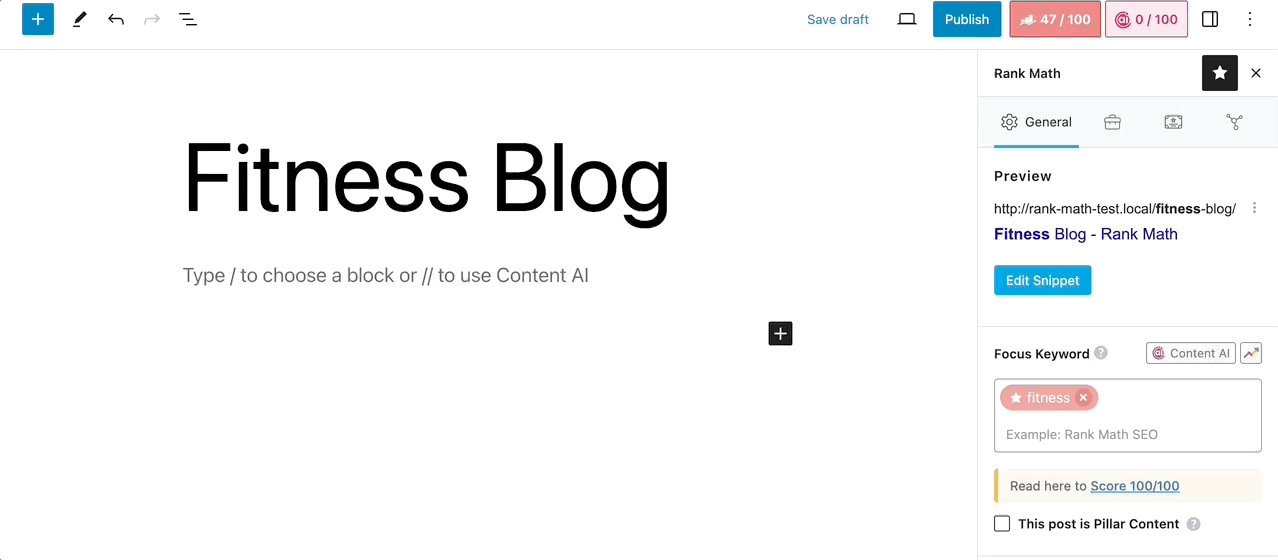
RankBot, a part of Rank Math’s Content AI, simplifies keyword research by using AI to organize and suggest keyword ideas based on specific prompts.
You can use a prompt available in RankBot’s Prompt Library, and the AI will analyze relevant keyword ideas.
To generate long-tail keywords, use the Long-tail Keywords prompt, as shown below.
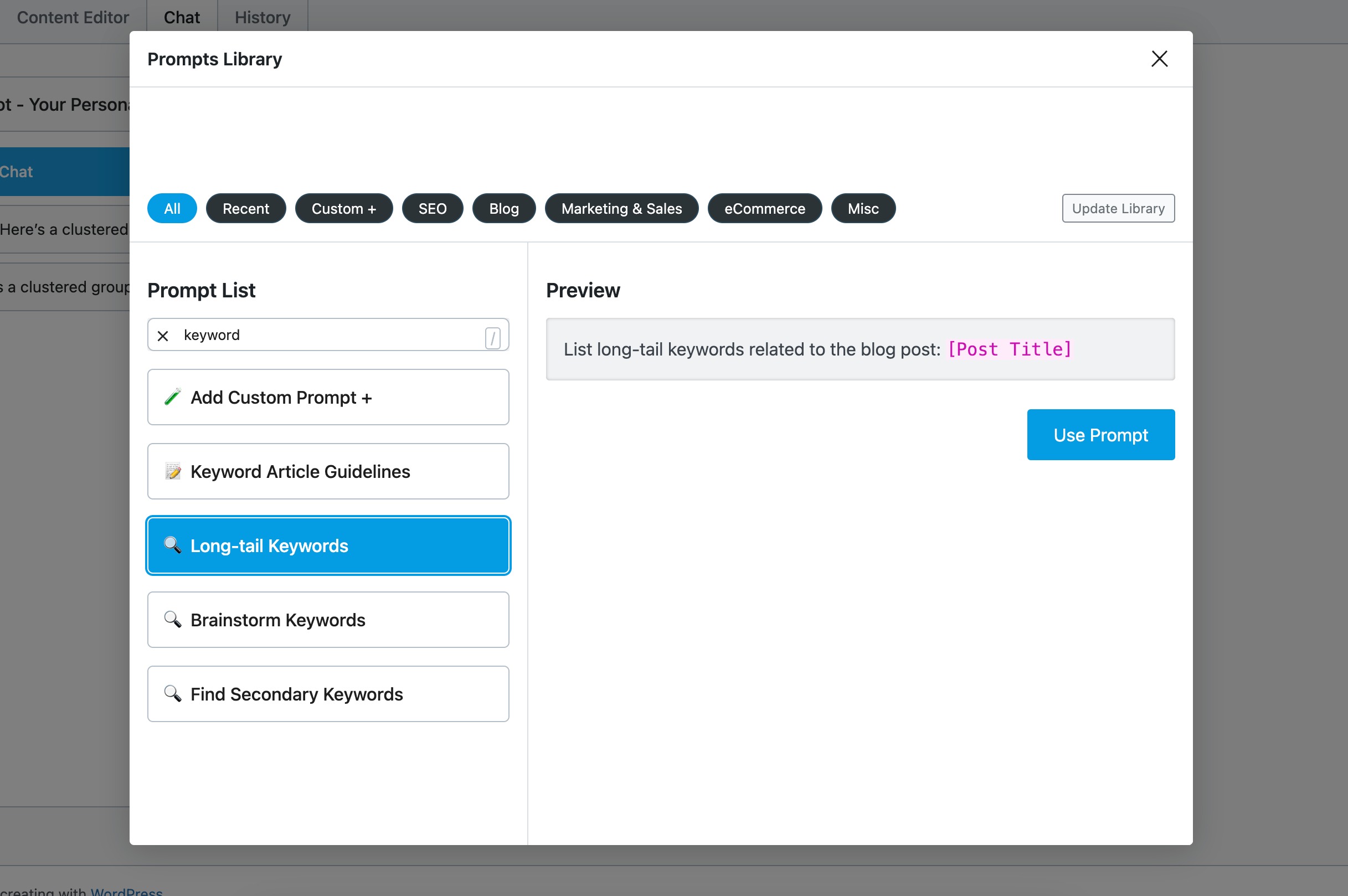
Click on Use Prompt to command it to RankBot.
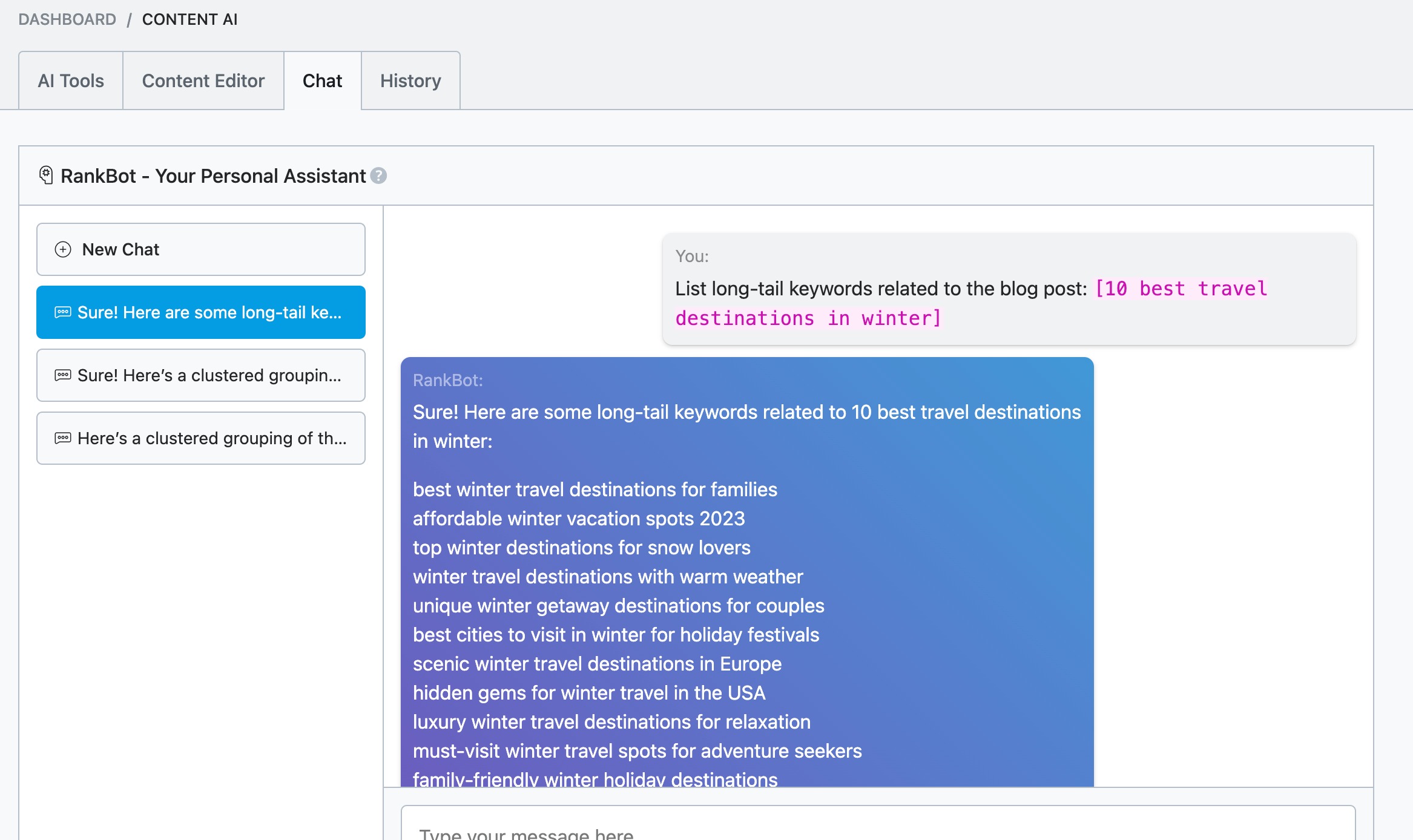
Similarly, use the Brainstorm Keywords prompt in the Prompt Library to brainstorm keywords in your niche. This prompt is particularly useful when you’re starting a new content project and need various keyword ideas related to your topic.
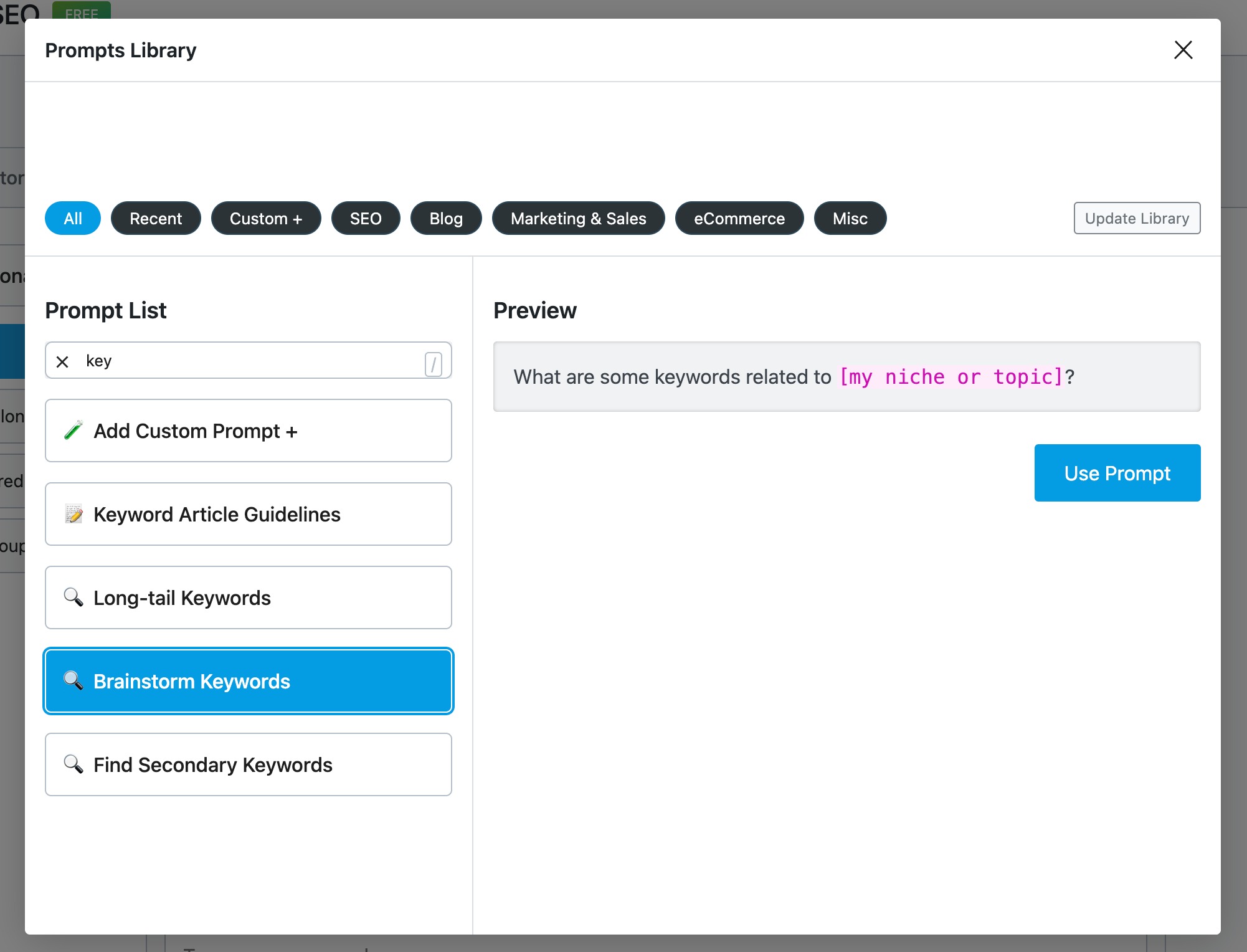
With the help of this prompt, RankBot will generate a diverse list of keyword suggestions based on your topic.
It’s a fast way to generate ideas and keep your content SEO-friendly.
Google Keyword Planner
Google Keyword Planner is a free tool that gives you keyword ideas, along with estimated monthly search volume and competition.
While it’s primarily designed for those interested in running paid Google ads, it’s equally effective for discovering keywords.
Here are a few keyword ideas that Google Keyword Planner provided for the seed keyword fitness:
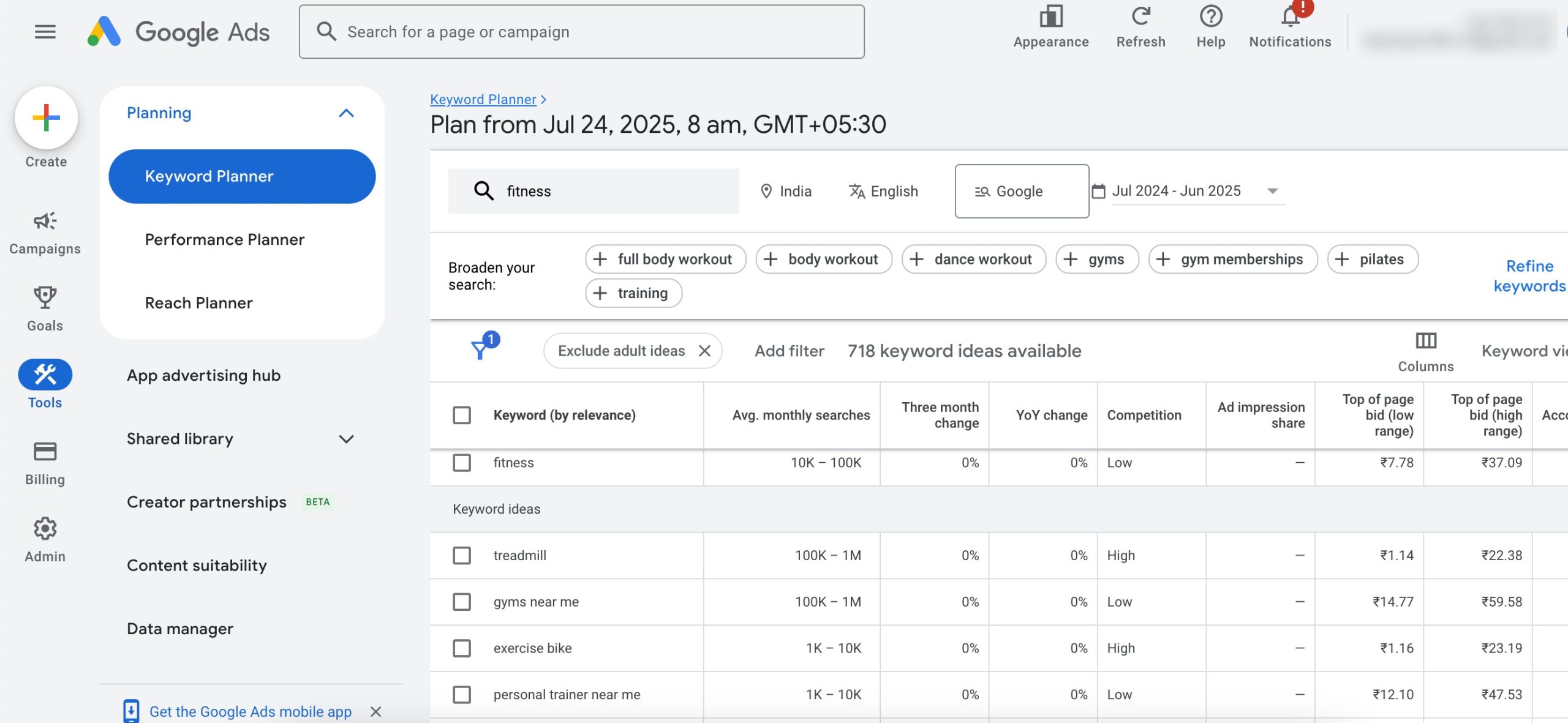
Other Tools: Ubersuggest, Ahrefs, Semrush, etc.
These tools go deeper with features like:
- Keyword difficulty score
- SERP analysis
- Keyword gap analysis
- Content ideas based on keyword performance
4.4 Check Your Competitors
Sometimes, the easiest way to find keyword ideas is by looking at what’s already working for others in your space.
Start by identifying a few competitors, websites or blogs that target a similar audience or offer similar products.
Let’s say you run an online pet store and your competitor ranks for:
- grain-free dog food
- Best toys for puppies
- dog grooming at home
You can use these as inspiration, either by improving on their content or targeting related long-tail keywords they’ve missed.
Reverse-Engineering Their Strategy
Take a closer look at:
- What kind of content is ranking (blogs, product pages, guides)
- What keyword clusters do they target
- How they structure their content (FAQs, comparisons, tutorials)
This helps you figure out not only what to write, but how to write it for better results.
Refer to our dedicated tutorial on finding competitor keywords.
5 Analyze Keyword Metrics
Once you’ve gathered a list of keyword ideas, it’s time to dig into the data behind those keywords. Not all keywords are created equal—some are more valuable to target than others, depending on your goals. Here are the key metrics you should evaluate.
5.1 Search Volume
Search volume tells you how many times a keyword is searched per month. It helps you estimate the potential traffic you could gain if you rank for it.
What’s a good search volume?
That depends on your niche. For example:
- If you’re in a broad niche like fitness, a keyword with 10,000+ monthly searches might be worth targeting.
- But in a narrow niche like vegan fitness for moms, even 500 searches per month can be gold.
Google Keyword Planner generates a list of keyword ideas along with their average monthly search volume.
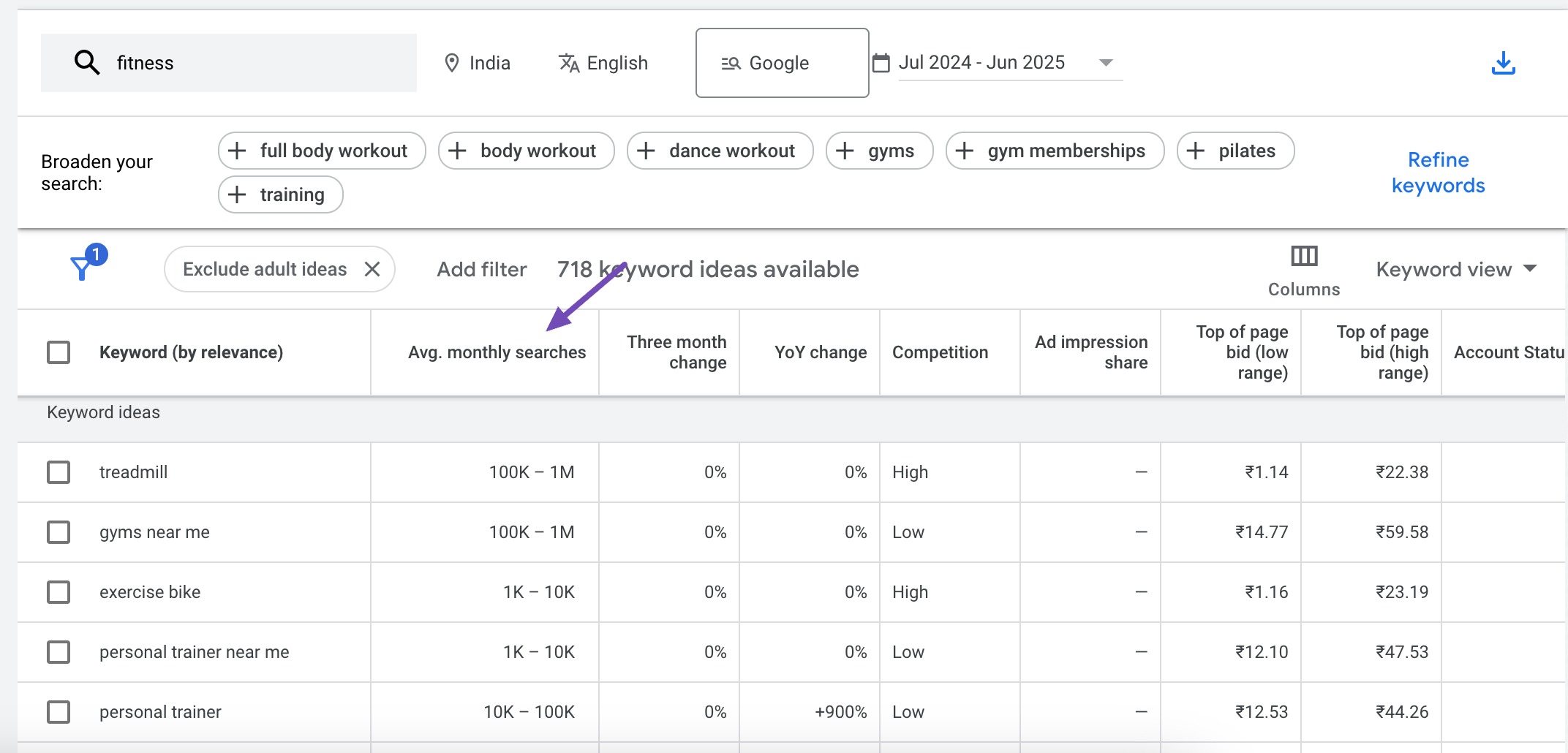
Don’t chase high-volume keywords just because they look impressive. They’re often more competitive and less targeted. Focus on finding a balance between volume and relevance to your audience.
5.2 CPC (Cost-Per-Click)
CPC tells you how much advertisers are willing to pay when someone clicks on an ad for that keyword. This is useful if you’re looking at commercial intent.
Why should you care about CPC?
If a keyword has a high CPC, it often signals strong buying intent. That means people searching for it are likely ready to take action—buy, sign up, or hire someone.
Even if you’re not running ads, CPC gives you a clue about how valuable a keyword is from a business standpoint.
In the Google Keyword Planner, look for:
- Top of page bid (low range)
- Top of page bid (high range)
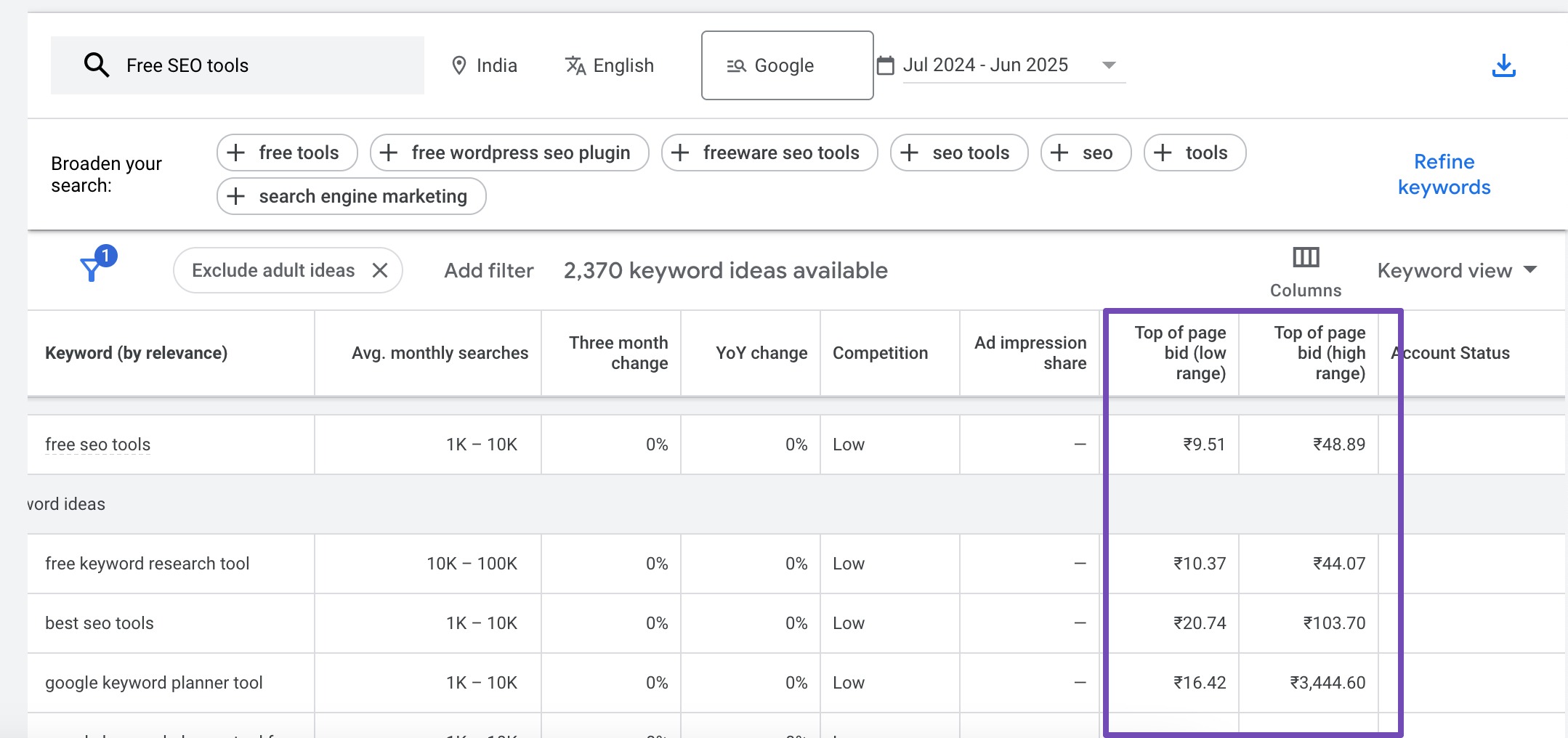
These represent the estimated CPC advertisers pay for showing up at the top of search results.
Also, Rank Math’s Analytics feature keeps track of metrics such as total search traffic, total impressions, total ranking keywords, click-through rate, and much more.
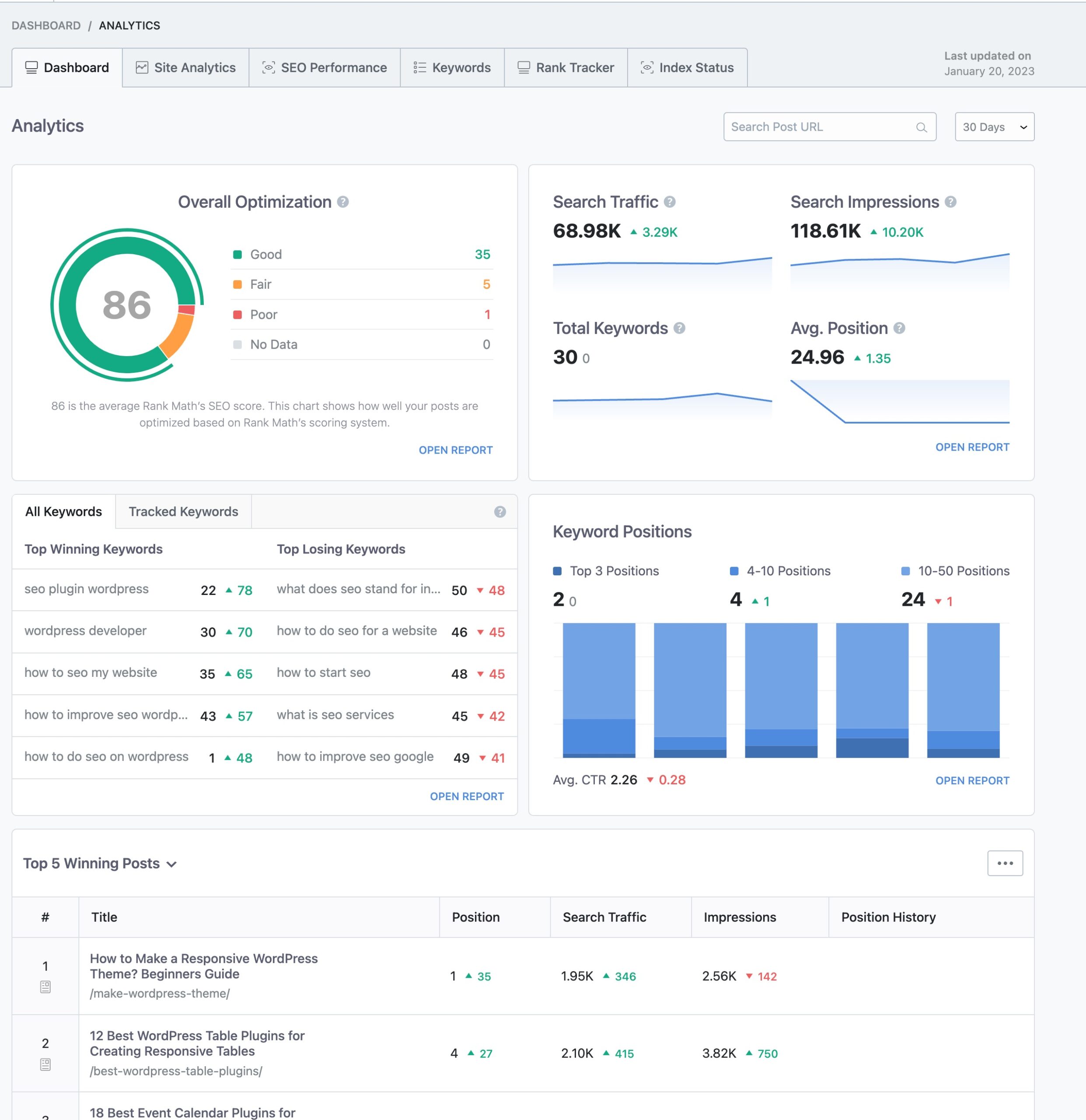
5.3 Trends Over Time
Some keywords are evergreen, while others are seasonal or rising in popularity. Using Google Trends, you can spot how interest in a keyword changes over time.
Example:
- Christmas gift ideas spike in November–December.
- AI writing tools may show rising interest across the year.
By understanding seasonality and trends, you can:
- Avoid investing in declining topics
- Plan your content calendar accordingly
- Catch trending topics early
6 Use a Spreadsheet to Plan Before You Start Writing
Before jumping into content creation, it helps to organize your keyword research in a spreadsheet. This gives you a clear overview of what you’re targeting and why, and helps you avoid overlapping topics or missing opportunities.
Here’s how you can structure it:

When you create a spreadsheet like this, you can prioritize content based on a mix of volume, intent, and difficulty. You also make sure you’re not writing multiple articles for the same keyword, which can confuse search engines and hurt your rankings.
Start simple. You don’t need a fancy tool, Google Sheets works great. Over time, update the sheet with performance data like clicks or rankings, so you can revisit and improve your strategy based on what’s actually working.
7 Track and Monitor Keywords
Tracking and monitoring keywords is important to ensure your website’s ongoing visibility and performance.
You can start by configuring keyword tracking tools like Google Search Console, or even Rank Math’s Rank Tracker. These tools allow you to monitor your website’s keyword performance, discover ranking changes, and identify opportunities and issues.
To track keywords in Google Search Console, navigate to the left-hand menu and click on Performance. In the Performance report, you’ll see various data, including total clicks, total impressions, average click-through rate (CTR), and average position. This data gives you an overview of how your website is performing in Google search.
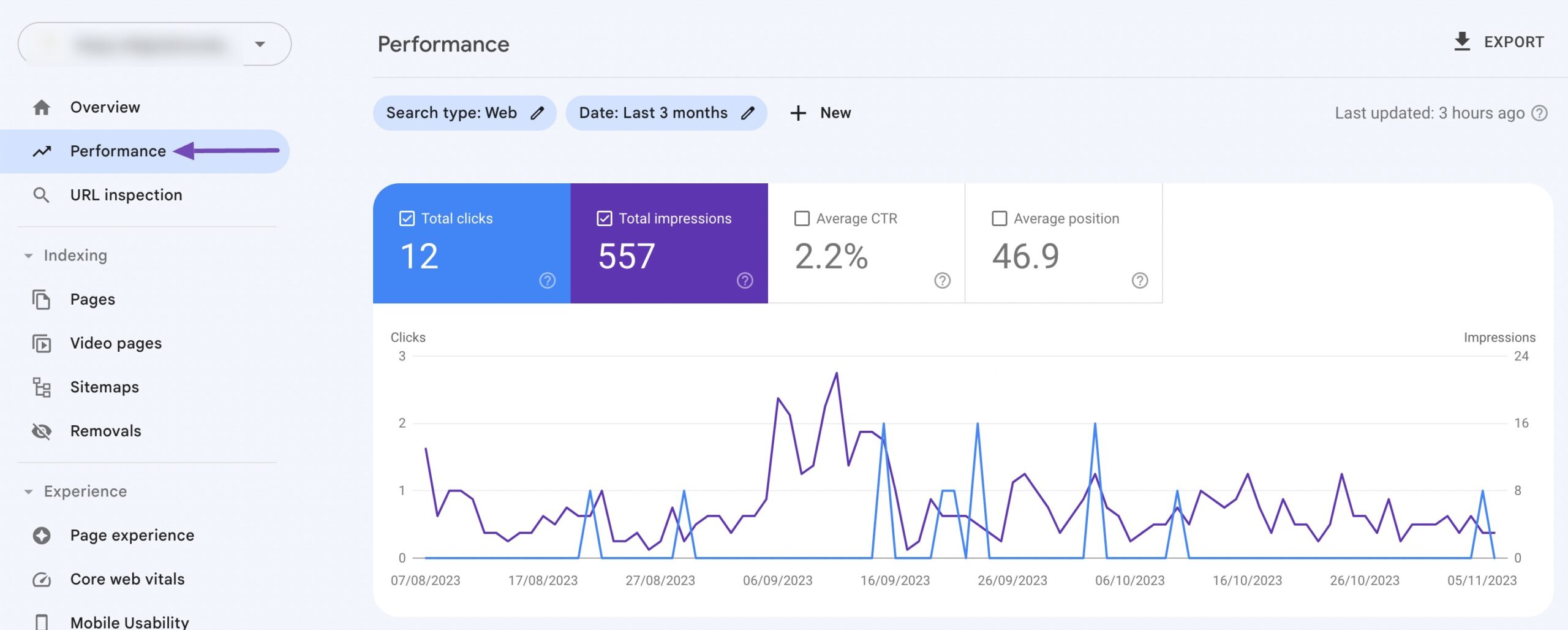
To track keywords, click on the QUERIES tab under the Performance report. This will display a list of the keywords that users have used to find your website.

Rank Math PRO offers Rank Tracker to help you track the keyword performance of your selected keywords. It offers keyword tracking, historical data, automatically add focus keywords from your posts, and much more.
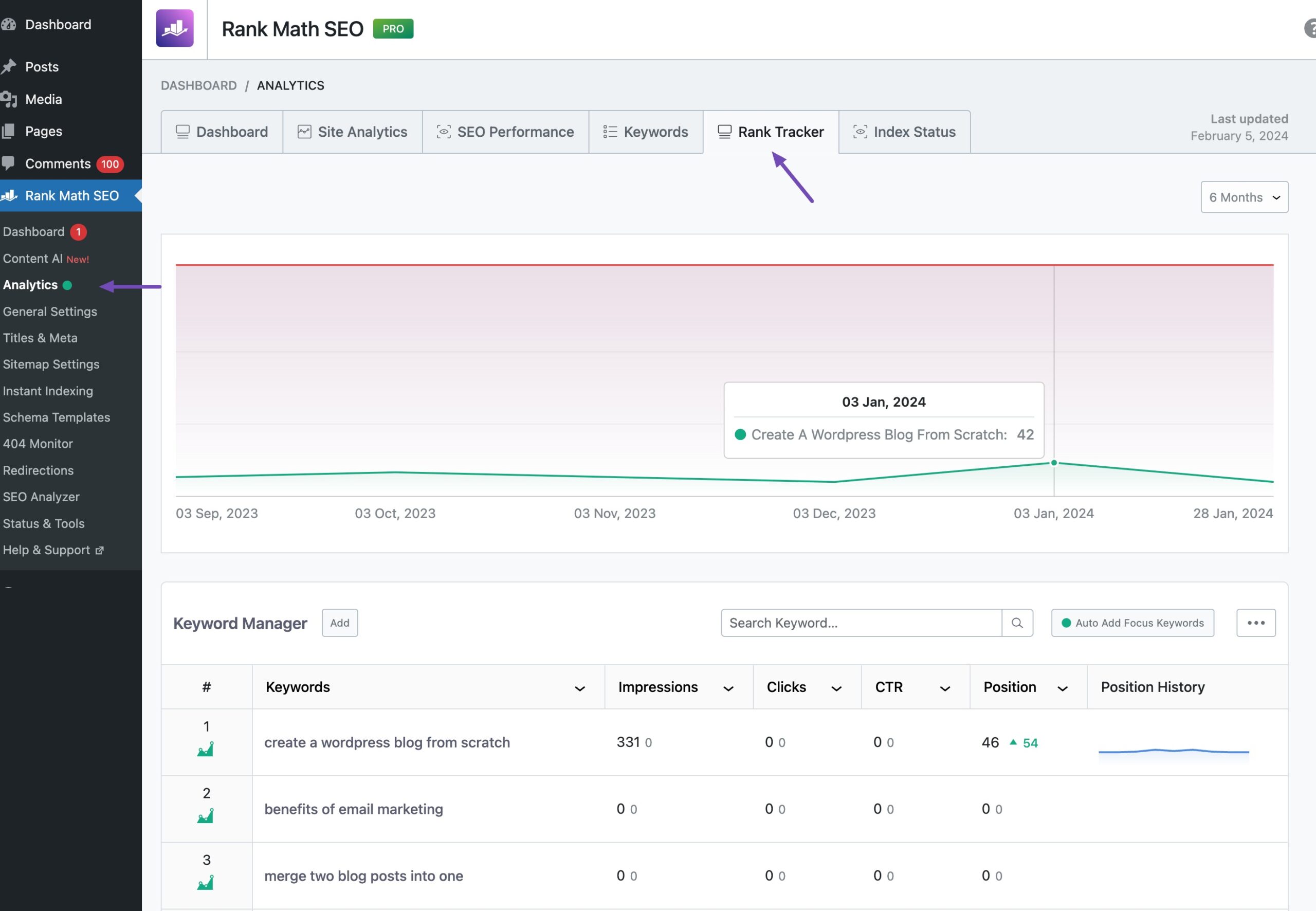
8 Adjust Content Based on Keyword Performance
Once you’ve published a piece and started ranking for your target keywords, the work isn’t over—you’ll want to refine that content based on how it’s actually performing.
8.1 Update Content for Clarity and Relevance
If your page is ranking, but not as high as you’d like—or if it’s slipping—it might be time for a content refresh.
Improve clarity by rewriting unclear sections or simplifying explanations. Add freshness by updating outdated stats, screenshots, or examples.
Fill gaps by including missing details or addressing related questions users may have (check the “People Also Ask” box in Google).
8.2 Optimize for New Keyword Variations
Over time, your content may start ranking for keywords you didn’t originally target. These can be discovered in Google Search Console under the Performance tab.
- Look for long-tail variations or related search queries you’re appearing for.
- Weave those terms naturally into your headings, body content, or FAQs.
For instance, if you’re ranking for how to do keyword research and also showing impressions for keyword research steps, consider adding a section with step-by-step instructions using that exact phrase.
8.3 Add Internal Links
Internal links pass authority between pages and help search engines crawl your site more efficiently.
Link from high-traffic pages to underperforming ones. Use relevant anchor text based on your target keywords.
8.4 Improve Title Tags and Meta Descriptions
Sometimes your content ranks decently, but the click-through rate (CTR) is low. This can mean your title and meta description aren’t compelling enough.
- Include power words or numbers (e.g., “10 Proven Tips”).
- Address search intent—does your title solve a specific problem?
- Match what users are seeing in the SERPs from your competitors.
If you’re struggling to create title tags and meta descriptions, you can use our SEO Meta AI tool. Simply enter the topic, and the tool will generate a title and description, as shown below.
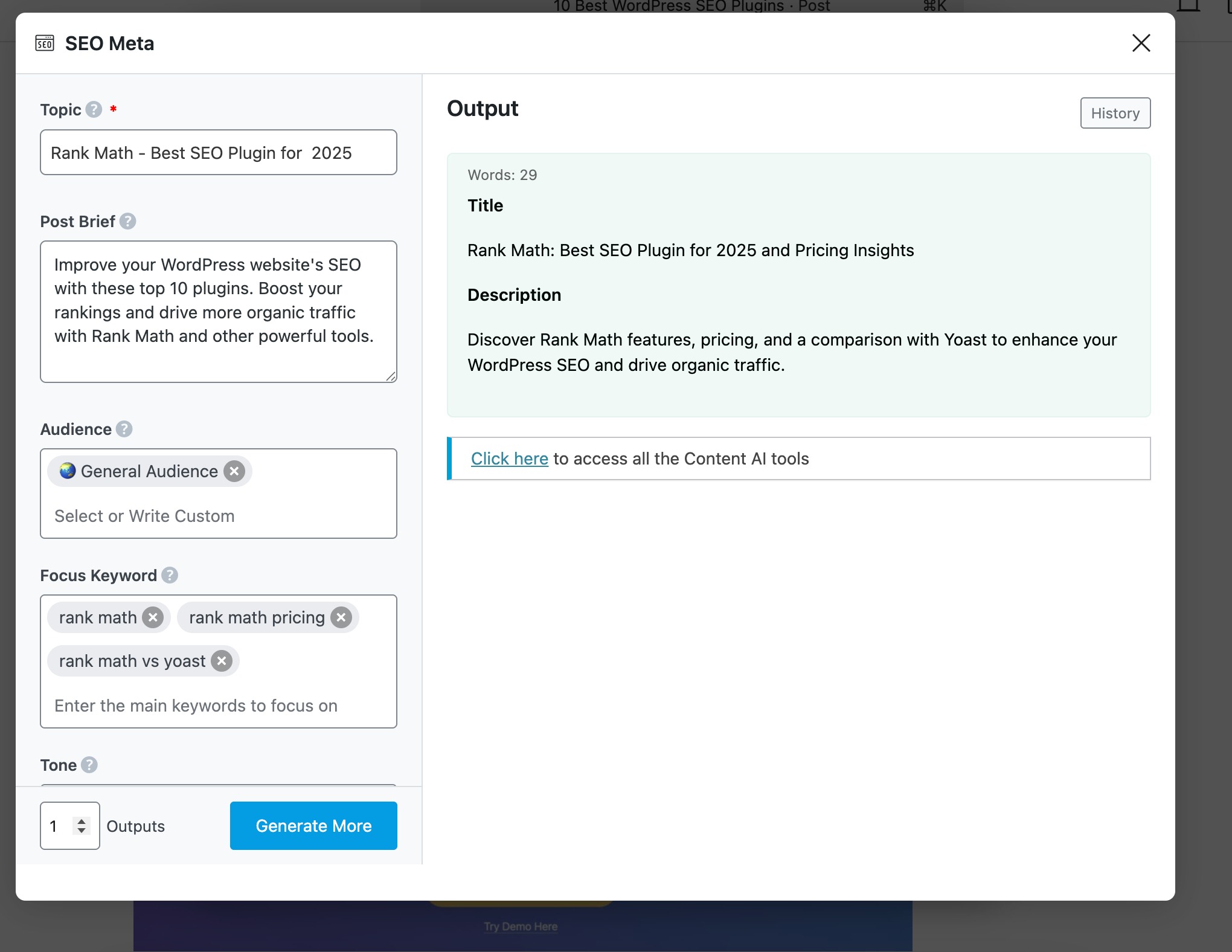
8.5 Use Rank Math to Simplify This Process
If you’re using Rank Math, you can:
- View your top-performing and underperforming keywords directly in your WordPress dashboard with Google Search Console integration.
- Get content suggestions based on your target keywords using Content AI.
- Use the SEO Analyzer to identify missing elements like keyword placement, headings, and internal links.
9 Frequently Asked Questions
How often should I research keywords?
Keyword research should be an ongoing process. You should revisit and update your keyword strategy regularly to adapt to changes in search trends, user behaviour, and your industry.
Can I use the same keywords for every page on my website?
It’s best to use a variety of keywords across your website’s pages. Each page should target specific keywords related to its content, ensuring that your website addresses a wide range of user queries.
How can I measure the success of my keyword research efforts?
You can measure the success of keyword research by tracking keyword rankings, organic traffic, click-through rates, and conversions. Tools like Google Analytics and Google Search Console provide valuable data for this purpose.
Should I focus on high-search-volume keywords or low-competition keywords?
The ideal approach is to strike a balance between high-search-volume keywords and low-competition keywords. High-search-volume keywords attract more traffic but are often competitive, while low-competition keywords are easier to rank for but may have lower traffic.
What is the difference between organic and paid keywords?
Organic keywords are those for which your website appears in search results naturally. Paid keywords are used in paid advertising campaigns, like Google Ads, where you pay for your website to appear at the top of search results for specific keywords.
10 Wrapping It Up
Keyword research helps you figure out what your audience is actually looking for so you can create content that matches their needs. It’s not just something you do once and forget—it’s something you should come back to regularly.
As you’ve seen, it’s important to think about things like search intent, keyword difficulty, and how keywords fit into your content. You don’t have to target only high-volume terms. In fact, more specific keywords often bring better results.
Once you publish content, keep an eye on how it’s performing. Update it when needed, and look for new keyword opportunities over time.
If you’re using Rank Math, we’ve built a lot of helpful features—like suggestions, keyword tracking, and on-page checks—to make this process easier. Use them to your advantage and keep improving your content step by step.
If you like this post, let us know by Tweeting @rankmathseo.
